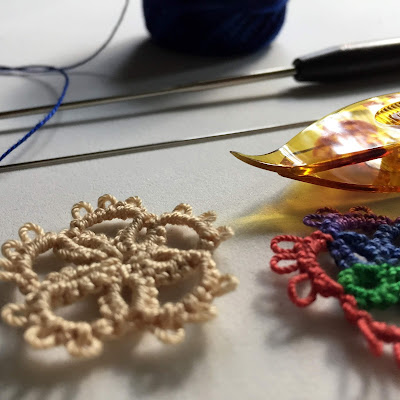A Newbie's Cro-Tatting, Needle Tatting, and Shuttle Tatting Comparison
Tatting is a type of lace making, and there are three ways to go about creating tatted lace: shuttle tatting, needle tatting, and cro-tatting, which is a crossover between crocheting and tatting.
When I was new to tatting, I found it very helpful to learn all three methods in order to better understand each one and the differences between them. The samples in the title image are my own "newbie" samples.
One of the biggest differences I have found is in the tightness or "thickness" of my completed projects. In shuttle tatting, the double stitches used in tatting are built onto the thread itself, so the stitches are as tight or as small as the thread. In needle tatting the stitches are built onto the needle, which holds the thread in its eye, and therefore two thicknesses of thread are pulled through the rings when the rings are closed, or through the chain when the chain is made. If I make the stitches too tight, I have a very difficult time pulling the needle, the core thread, and the tail thread through the double stitches. Cro-tatting is similar to needle tatting in that two thicknesses, or a doubled length of thread, is pulled through the ring after the stitches are built onto the cro-tatting hook, and in order to close a ring the hook has to be wiggled through the double stitches. For that, the larger and more consistent the double stitches the better! I have also found that even the smallest cro-tatting hook I can find and easily use is fairly large compared to a tatting needle. The thicknesses of the completed projects, therefore, can be very different - especially for newbies who need a little extra "wiggle" room.
Other differences, like speed and ease, are entirely subjective, and for every person who prefers shuttle tatting, like Karen Cabrera, there is a person who prefers needle tatting, like RustiKate, and both can be done with speed. When I want to try something quickly, I opt for needle tatting. Yet, as someone who has crocheted for over 30 years, I generally reach for my cro-tatting hook when I start a new project, but I carry my shuttle tatting in my purse because it easily fits into an old Altoids tin. With my cro-tatting hook and tatting needles, which are fairly long, I would worry about breaking them if I carried them with me too often.
There are other subtle differences that make different forms of tatting more difficult at given times. With needle tatting, for example, I need to make sure I have a needle threader handy and know how much tail thread to leave. With shuttle tatting I need to make sure I know whether I need one shuttle or two, attached to the ball or not, and with cro-tatting I have to know that my crochet chain, versus double stitches, will not change the look of the pattern too much for my personal aesthetic.
The price of the tools is also quite similar among the three methods. There are several options available for all three. The Handworks from the Heart blog has an excellent post about cro-tatting hooks. I most often use my Annie's brand cro-tatting hook, and I also use a Prym brand hook on occasion because it is a bit smaller. When I work with yarn I use a Tunisian crochet hook for cro-tatting. My favorite tatting shuttles (Affiliate Link) with bobbins are made by Susan Bates, but I also really like my small Clover shuttles without bobbins. Handy Hands has a great set of tatting needles for a variety of thread sizes (that also comes with threaders and a small instruction booklet), and I have found that simply having that one set is enough for me.
So what does this all mean? What is my recommendation? Because the cost is minimal, and the feeling of accomplishment in trying all three is high, I recommend trying all three and seeing which works best for you in any given situation or with any given pattern. Personally, I enjoy all three for different reasons and am exceptionally glad I've given all three a try!
Want to read more about Arts and Crafts? Try
Cro-tatting Rows of Rings: Split Rings and Stacked Rings
Punch Needle Embroidery Supplies for Beginners
Which Weaving Loom is Best for Beginners?
Copyright Amy Lynn Hess. Please contact the author for permission to republish.





Comments
Post a Comment